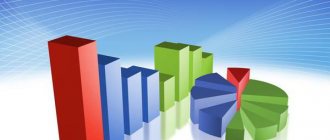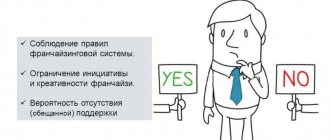Financial stability is another criterion by which the degree of success of a company, its solvency and solvency are determined. However, there is a difference between the concepts of sustainability and the already indicated solvency. Sustainability refers to the correspondence of funding sources to the income structure, and solvency is an analysis of short-term liabilities and current assets. To determine the financial stability of the enterprise, you need to understand where the company gets money from and how income relates to assets.
The economic sustainability of a certain organization is considered a macro indicator with the help of which an entrepreneur learns about the current state of affairs in a business project. Financial stability indicators are determined at short intervals and make it possible to draw up the right economic development strategy for the future.
If you are interested and want to know how the financial stability indicator is calculated, what it gives and how to properly use the data obtained, read our analytical material.
Financial stability of an enterprise: what is it?
The financial stability of an organization is an indicator of the stability of the enterprise's position. How exactly is stability ensured? Using a significant (sufficient) share of your capital as part of the sources of financing.
A sustainable enterprise is an economic entity that uses borrowed funds within reasonable limits, that is, borrows only what it can repay. For the simplest understanding, stability can be compared to the solvency of an ordinary individual. If a Russian borrows an amount greater than he is able to repay, further bankruptcy is possible. So it is with legal entities. Stability is determined by the sustainability of a particular enterprise.
The type of financial stability directly depends on how much short-term liabilities exceed or do not exceed the value of liquid assets. Liquid assets mean only current ones - that is, those that can be quickly converted into money and not experience a loss in value.
Liquid assets are inventories and work in progress. If the entrepreneur decides to turn them into money, then the activity of the enterprise will not suffer. Liquid assets also mean accounts receivable, the transformation of which into cash equivalent is considered a natural process.
The indicator of economic and financial stability makes it possible to sensibly analyze the company’s position and predict how it will develop further.
Having briefly recalled what is meant by current assets, let us return to the indicator of the organization’s sustainability. It was said above that the financial stability ratio is calculated based on the ratio of assets and liabilities. If, after deducting liabilities, zero remains, then the company cannot be called successful, moreover, it is threatened with bankruptcy or partial insolvency. After all, a zero coefficient literally means that after paying off short-term obligations, the company will have no assets left.
The financial stability coefficient may even be negative. Such indicators indicate that it is time to sound the alarm, otherwise bankruptcy will appear on the horizon. And finally, if the coefficient turns out to be positive, carefully analyze its value. After all, short-term obligations are short-term because they change quickly. If the ratio shows a very small difference between assets and liabilities, you may need to hold off on further borrowing to avoid ending up in a difficult situation.
What determines financial strength
This indicator is mainly calculated in the presence of mass production with a short period of the production cycle.
It is worth noting that the more insignificant the expenses (and this especially applies to constant ones), the more this indicator grows, but basically the determination of financial stability is carried out on the basis of three situations:
- sales and production volumes completely coincide;
- sales volume is greater than production volume;
- sales volume is less than production volume.
A separate division of a legal entity located outside the main location is considered territorial. You can download OKVED codes 2017 with decoding from here.
It is worth noting that in order to fully assess the financial strength of a company, it is necessary not only to carry out calculations in accordance with the specified formula, but also to analyze all possible aspects present in the economic activities of the company, and first of all, this concerns how much the difference between the sales and production volumes affects the work of the organization, as well as how the amount of inventory increases.
Types of financial stability
The modern economy provides many opportunities to understand what is happening with the enterprise. Therefore, it is not surprising that such an important tool as sustainability calculation includes several parameters (without formulas) that indicate the state of affairs at the enterprise. Let's talk about each of them!
Absolute stability
When we talk about the absolute stability of a financial enterprise, we should not even talk about the calculation formula, but about the results of this operation. Absolute financial stability is a situation when all the company’s reserves are covered by its own working capital.
In other words, when the company has no loans, debts to suppliers, and so on. Such a company does not depend on external funds; it is self-sufficient and independent. It is worth noting that absolute sustainability, although all businessmen strive for it, is very rare. The era of cheap, profitable loans has influenced entrepreneurship in general. Free money is often regarded as an opportunity today to expand production, enter a new market, increase productivity, etc.
Normal financial stability of the enterprise
If an enterprise uses not only working capital, but also long-term borrowed funds, we can talk about normal sustainability. There is no threat to such an enterprise; it is stable and has its own capital. And borrowed funds, as we mentioned above, are really used for development, and not for maintaining life and repaying other payments on obligations.
Normal financial stability is what all entrepreneurs should strive for. This is the very balance that allows you to stay afloat and use the funds raised. Mathematically, normal indicators of sustainability can be shown by the following inequality: the sum of inventories and costs < working capital + long-term liabilities (the sum of inventories and costs is less than working capital and liabilities).
How to find it?
When calculating the ratio, the organization's balance sheet is used.
Balance calculation formula:
- Kfin. mouth = (line 1400 + line 1300)/line 1700.
Full transcript:
- Kfin. mouth = (equity + long-term liabilities)/balance sheet liabilities.
When calculating, long-term liabilities are added to the equity capital of the enterprise, since they have been at the disposal of the company for quite a long time. The recommended value of the coefficient is the indicator 0.8-0.9.
You can get detailed information about this coefficient from the following video:
https://youtu.be/XXT92_ChbbM
Example
Let’s say organization N has 500 million rubles of its own funds + long-term loans in the amount of 300 million. The balance sheet currency is 970 million. Then the coefficient will be equal to:
- (500 + 300)/970 = 0.82
Acceptable financial stability of the company. The bank will be able to give her a loan.
At the same time, their competitors, organization M, have more own funds - 600 million rubles, but they took out long-term loans in the amount of 100 million with the same balance sheet liabilities. In this case, the indicator will be equal to:
- (600 + 100)/970 = 0.72
The financial stability of the enterprise is low.
Lenders will prefer not to contact this organization. How to correctly fill out a personal salary account - read in this article. What is a confidential information non-disclosure agreement - see here.
Unstable financial situation
If current assets and long-term liabilities have a smaller value than the totality of inventories, costs, working capital, long-term liabilities and short-term loans, then it is worth talking about an unstable situation.
Economists argue that certain markers indicate that an activity is unsustainable. For example, a violation of solvency (replenishment of sources of own funds, reduction of accounts receivable, acceleration of inventory turnover and some other negative trends).
The stability coefficient, however, has a negative value.
Consequences of an unstable situation
Indicators calculated according to the model indicate the company's position in the market and how soon it will encounter troubles. Unsustainability is characterized by consequences. Among them are delays in wages, the use of available funds from reserve funds for other purposes, interruptions in the flow of money to current accounts, unstable profitability, and failure to fulfill the financial plan.
In a word, very soon an unstable enterprise may cease to be a reliable partner both for its own employees and for contractors.
Crisis type of economic and financial stability
A financial crisis is a wake-up call for a company. This means that it is literally on the verge of bankruptcy. Securities, accounts receivable and own current assets no longer cover credit debt; moreover, there are overdue courts that are already in arrears. Mathematically, the crisis state can be reflected as follows: the totality of working capital, liabilities and short-term loans of the amount < inventories and costs.
What to do if the formula showed crisis financial stability?
The type of economic and financial sustainability of the crisis plan suggests that urgent action must be taken to save the situation. Negotiations should begin with creditors, raise all possible funds to pay off arrears, and perhaps decide to increase the authorized capital.
The main thing you shouldn’t do is wait for the situation to form on its own. Financial stability is a sensitive indicator, and this parameter really shows the true state of affairs in the enterprise.
If you receive a negative coefficient, you will soon encounter difficulties. But you can take advantage of the advantage you get from learning about the current state of affairs in advance.
Results
Now you know what financial stability is. To calculate it, we need only two main parameters - the value of our own assets and liabilities to counterparties and creditors. Obviously, the indicator will be considered normal if the volume of assets more than covers the liabilities. A different situation threatens significant troubles, for example, bankruptcy. To correctly determine the stability indicator, entrepreneurs often involve professional economists.
There are several types of stability: absolute (the company does not raise funds at all through loans and borrowings, it completely covers its needs with its own funds), normal (there are loans and credits, but their value is not critical, and its own assets allow you to repay the money in a timely manner), unstable (there is less money than needed, so the company is unstable, delays or delays in wages may occur) and crisis (bankruptcy).
Conduct a sustainability assessment at least once a year to prevent problems from arising and respond promptly to a decrease in the ratio.
Data characteristics
To carry out calculations correctly, you need to obtain certain characteristics from which you can build on in this process, and also understand exactly how such calculations should be carried out.
detailed instructions
The standard version of calculating the margin of financial safety in price terms looks like the above formula, that is, the planned sales volume is multiplied by the cost of each product, after which the product of the break-even point and the cost of each product is subtracted from it.
There is also another option for how to determine an indicator of the company’s financial strength, according to which the excess between the profitability threshold and the actual production volume will be established. Thus, the stock will be established as the difference between the company's profit and the profitability threshold established for it.
The profitability threshold is a state in which the organization's financial reserves are only sufficient to cover fixed costs, while the company itself does not have any profit.
Graphical view of the FP and break-even point
Types and acceptable actions
Analysis of the financial condition of a company is carried out with varying degrees of detail, but there are only two types of this procedure - express or in-depth.
Express analysis only provides for obtaining a general idea of the organization’s work, and its main goal is to determine the state of financial well-being and the further dynamics of the organization’s development.
This procedure involves studying reports according to certain formal criteria, such as the correctness of the reports, the consistency of the final indicators, checking the control relationships between certain reporting items, as well as familiarizing with the conclusions made by the auditors.
In the process of conducting an in-depth analysis, specialists can get a rough idea of the following nuances of the company’s work:
- solvency and liquidity;
- financial strength;
- property status;
- income and profitability;
- work activity.
Thus, in order to determine the financial strength of an organization, an in-depth analysis must be carried out, since in the process of its implementation many indicators are established that are not established during an urgent audit.







